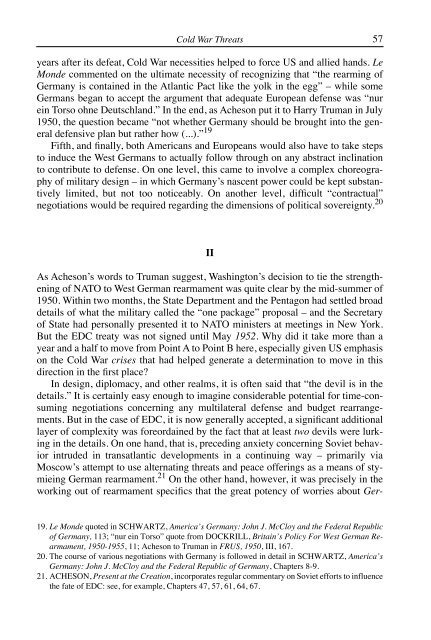journal of european integration history revue d'histoire de l ...
journal of european integration history revue d'histoire de l ...
journal of european integration history revue d'histoire de l ...
You also want an ePaper? Increase the reach of your titles
YUMPU automatically turns print PDFs into web optimized ePapers that Google loves.
Cold War Threats 57<br />
years after its <strong>de</strong>feat, Cold War necessities helped to force US and allied hands. Le<br />
Mon<strong>de</strong> commented on the ultimate necessity <strong>of</strong> recognizing that “the rearming <strong>of</strong><br />
Germany is contained in the Atlantic Pact like the yolk in the egg” – while some<br />
Germans began to accept the argument that a<strong>de</strong>quate European <strong>de</strong>fense was “nur<br />
ein Torso ohne Deutschland.” In the end, as Acheson put it to Harry Truman in July<br />
1950, the question became “not whether Germany should be brought into the general<br />
<strong>de</strong>fensive plan but rather how (...).” 19<br />
Fifth, and finally, both Americans and Europeans would also have to take steps<br />
to induce the West Germans to actually follow through on any abstract inclination<br />
to contribute to <strong>de</strong>fense. On one level, this came to involve a complex choreography<br />
<strong>of</strong> military <strong>de</strong>sign – in which Germany’s nascent power could be kept substantively<br />
limited, but not too noticeably. On another level, difficult “contractual”<br />
negotiations would be required regarding the dimensions <strong>of</strong> political sovereignty. 20<br />
II<br />
As Acheson’s words to Truman suggest, Washington’s <strong>de</strong>cision to tie the strengthening<br />
<strong>of</strong> NATO to West German rearmament was quite clear by the mid-summer <strong>of</strong><br />
1950. Within two months, the State Department and the Pentagon had settled broad<br />
<strong>de</strong>tails <strong>of</strong> what the military called the “one package” proposal – and the Secretary<br />
<strong>of</strong> State had personally presented it to NATO ministers at meetings in New York.<br />
But the EDC treaty was not signed until May 1952. Why did it take more than a<br />
year and a half to move from Point A to Point B here, especially given US emphasis<br />
on the Cold War crises that had helped generate a <strong>de</strong>termination to move in this<br />
direction in the first place?<br />
In <strong>de</strong>sign, diplomacy, and other realms, it is <strong>of</strong>ten said that “the <strong>de</strong>vil is in the<br />
<strong>de</strong>tails.” It is certainly easy enough to imagine consi<strong>de</strong>rable potential for time-consuming<br />
negotiations concerning any multilateral <strong>de</strong>fense and budget rearrangements.<br />
But in the case <strong>of</strong> EDC, it is now generally accepted, a significant additional<br />
layer <strong>of</strong> complexity was foreordained by the fact that at least two <strong>de</strong>vils were lurking<br />
in the <strong>de</strong>tails. On one hand, that is, preceding anxiety concerning Soviet behavior<br />
intru<strong>de</strong>d in transatlantic <strong>de</strong>velopments in a continuing way – primarily via<br />
Moscow’s attempt to use alternating threats and peace <strong>of</strong>ferings as a means <strong>of</strong> stymieing<br />
German rearmament. 21 On the other hand, however, it was precisely in the<br />
working out <strong>of</strong> rearmament specifics that the great potency <strong>of</strong> worries about Ger-<br />
19. Le Mon<strong>de</strong> quoted in SCHWARTZ, America’s Germany: John J. McCloy and the Fe<strong>de</strong>ral Republic<br />
<strong>of</strong> Germany, 113; “nur ein Torso” quote from DOCKRILL, Britain’s Policy For West German Rearmament,<br />
1950-1955, 11; Acheson to Truman in FRUS, 1950, III, 167.<br />
20. The course <strong>of</strong> various negotiations with Germany is followed in <strong>de</strong>tail in SCHWARTZ, America’s<br />
Germany: John J. McCloy and the Fe<strong>de</strong>ral Republic <strong>of</strong> Germany, Chapters 8-9.<br />
21. ACHESON, Present at the Creation, incorporates regular commentary on Soviet efforts to influence<br />
the fate <strong>of</strong> EDC: see, for example, Chapters 47, 57, 61, 64, 67.

















